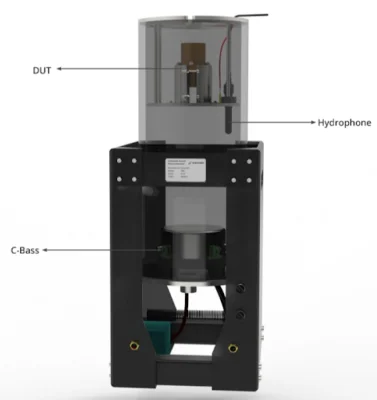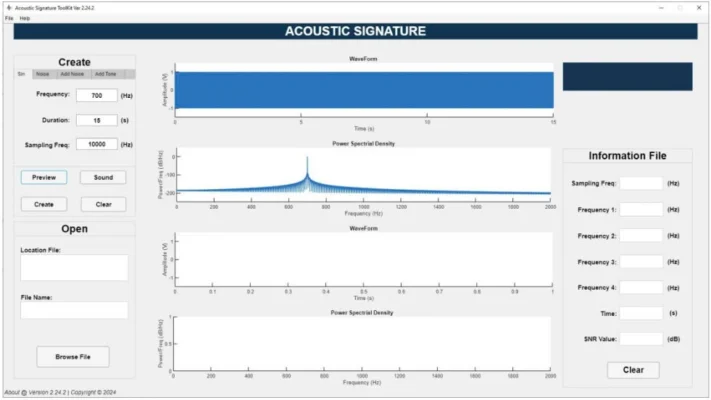1. Introducing the Underwater Acoustic Pressure Generator System
The Underwater Acoustic Pressure Generator is an advanced underwater acoustic simulation system designed to generate, measure, and analyze hydroacoustic signals. It is capable of simulating underwater acoustic pressure at very low-frequency bandwidths, either in an acoustic tank or in free-field environments. The system is widely used for equipment testing, underwater acoustic research, and the calibration of hydroacoustic detection devices.

2. System Components and Structure
The Underwater Acoustic Pressure Generator system consists of several key components, each playing a critical role in signal transmission, reception, and data processing:
2.1 Sound Transmission Equipment
- Wideband Power Amplifier (Krohn–Hite M7500): Provides high-power amplification with low distortion, ensuring accurate sound signal generation.
- Impedance Matching Transformer (Krohn–Hite MT56R): Expands the amplification range and allows for different impedance matching configurations.
- Electrodynamic Sound Projector (Geospectrum M72-300 C-Bass): Capable of transmitting single and combined tones, modulated signals, and white noise for various testing scenarios.
2.2 Acoustic Pressure Level Probe
- Hydrophone (Geospectrum M36-900): A highly sensitive, wide-band hydrophone used to monitor and calculate Sound Pressure Level (SPL) of the underwater signals.
2.3 Control Station
- Houses all the necessary modules for signal transmission, reception, and processing.
- Interfaces with a laptop controller via Ethernet (LAN).
- Includes power supply, amplifier, DAQ system, and matching transformer.
2.4 Acoustic Chamber
- Provides a controlled environment for testing underwater acoustic signals.
- Equipped with a water pump for controlled simulation conditions.


3. Functionality and Software
The system utilizes two integrated software components for acoustic signal generation and measurement:
3.1 Acoustic Signature ToolKit
- Generates standard hydroacoustic signals (sine, noise, combined tones).
- Displays signal waveforms and power spectral density.
- Saves generated signals in .wav format for further use.
3.2 MIM Test
- Uses generated signals to set up and execute measurement tests.
- Receives and processes signals from the hydrophone to calculate SPL.
Stores measurement data in .xlsx format for further analysis.

4. Applications
The Underwater Acoustic Pressure Generator system has a wide range of applications in underwater acoustic technology:
- Hydroacoustic equipment testing: Simulating underwater noise for testing detection devices and sonar systems.
- Scientific research: Used in marine studies and underwater acoustic signal analysis.
- Calibration of observation systems: Ensuring accurate detection and analysis of underwater acoustic signals.
5. Technical specifications
LF transmitting path
- Frequency range: 100 Hz to 1kHz
- Different options on request
- Signal level max: > 165dB re 1μPa @ 1 m at 115 Hz
- Beam pattern: Horizontally omnidirectional
- Signal pulse: Single and combined tone White or shaped noise
- Pulse length: 15s
- Operation depth max: 30m
Receiving path
- Standard Hydrophone:
- Frequency range: 100 Hz to 5Khz
- Sensitivity: -170 dB re 1 V/ μPa
- Beam pattern: Horizontally omnidirectional
- Maximum Operating depth:600m
- Sampling Frequency: up to 50 ksps
- Input range: ± 10V
- Resolution: 16 bits minimum
- Connectivity: Ethernet
Conclusion
The Underwater Acoustic Pressure Generator system provides a powerful and flexible solution for underwater acoustic simulation, signal processing, and testing. With advanced hardware and software integration, it offers precise control over acoustic signal generation and measurement, making it an essential tool for researchers and engineers working in the field of underwater acoustics.
To explore more detailed insights and applications, we invite you to discover additional application notes for other advanced devices and solutions.

